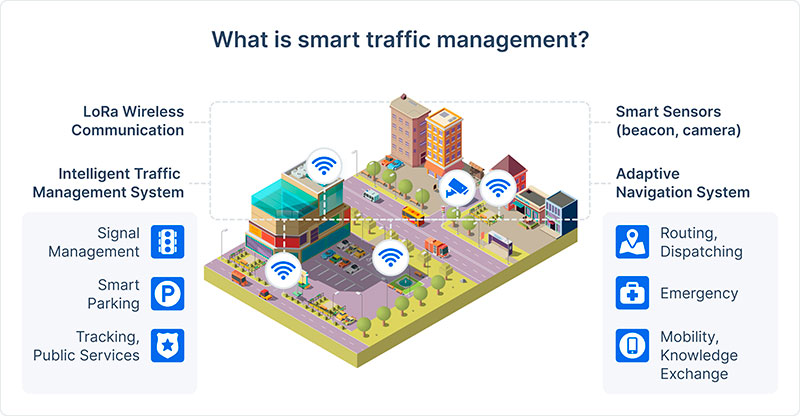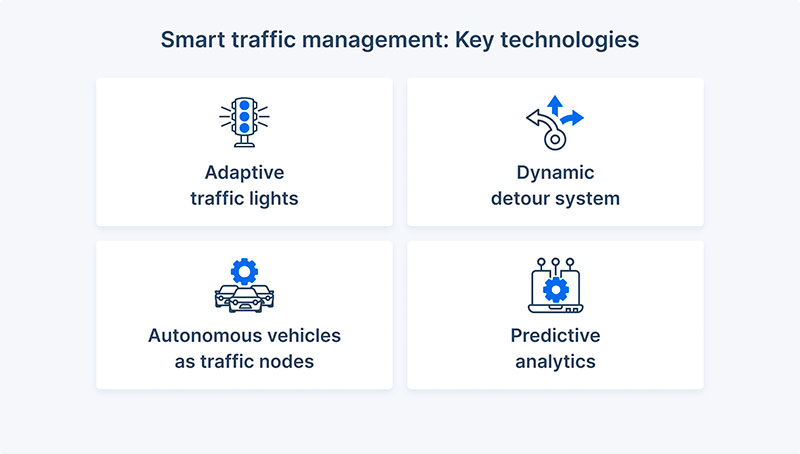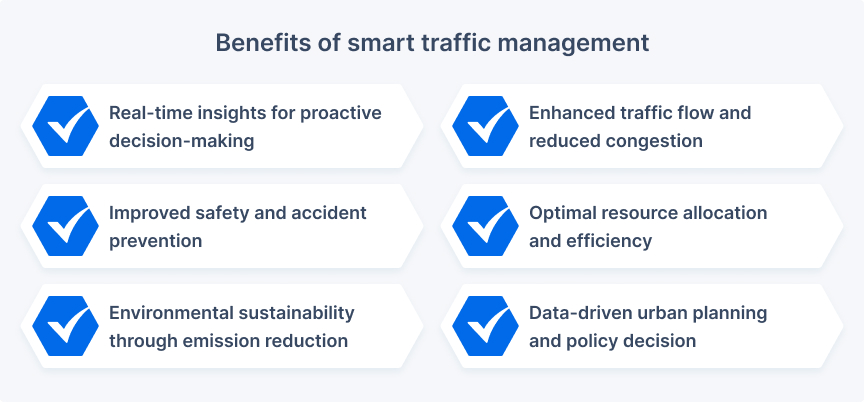IoT Monitor Traffic: Smart Traffic Control with IoT
December 21, 2023Traffic congestion, the bane of modern megacities, chokes not only our roads but also our economies, our health, and our precious time. But just as concrete canyons reach for the sky, so too does innovation. The Internet of Things (IoT) is enabling smart traffic management, which could be the game-changing answer we've been waiting for.
In this article, we will delve into the transformative potential of smart traffic management systems. Prepare to embark on a journey through smart traffic management, where the road ahead shines bright with the promise of a smoother, greener, and safer ride.
What is traffic management?
Traffic management, or traffic control, encompasses much more than just cones and detours. It's a comprehensive field dedicated to planning, implementing, and auditing traffic control plans to ensure the safe, efficient, and uninterrupted flow of people and vehicles during worksites and civil infrastructure projects.
What does traffic control involve?
Designing
Crafting detailed plans for lane closures, detours, pedestrian walkways, flagging operations, and temporary signage.
Implementing
Overseeing the physical setup of traffic control measures and ensuring strict adherence to the approved plan and safety regulations.
Auditing
Regularly inspecting and verifying that implemented measures are effective, safe, and comply with governing regulations.
What is smart traffic management?
In the realm of urban mobility, traditional traffic control systems have long grappled with inherent limitations, relying on static timing mechanisms, historical data, and a fundamental inability to adapt to the dynamic nature of real-time changes. The repercussions are evident: congested roadways, inefficient traffic signal timing, and frustrated commuters.

Urban traffic is constantly changing, and traditional traffic control systems are like old scripts: they can't keep up. However, smart traffic management solves these problems in a whole new way, bringing in an age of flexible and responsive automotive IoT solutions.
Just look at the numbers. The average American driver lost 51 hours in 2022 as a result of traffic, up 15 hours from 2021, according to the 2022 INRIX Global Traffic Scorecard. Due to traffic congestion, drivers lost an average of 80 hours in the UK, a 7-hour increase, and 40 hours on average in Germany, unchanged from 2021.
Thus, congestion costs $16.89 per hour in the United States, £8.83 per hour in the United Kingdom, and 10.08 € per hour in Germany (adjusted for inflation).
At its core, smart traffic management embraces the concepts of IoT traffic monitoring, connected vehicles, and IoT transportation and fleet management. This involves an intricate web of sensors, cameras, and interconnected vehicles seamlessly working together to collect real-time data on traffic flow, incidents, and even prevailing weather conditions. Unlike their static predecessors, these systems don't merely adhere to predefined norms but dynamically respond to the nuances of traffic patterns, ensuring optimal efficiency and safety.
Smart traffic management systems leverage this real-time data to optimize traffic flow in several ways. Let’s discuss them.

Adaptive traffic lights
Bid farewell to the predictability of red-light marathons. The advent of adaptive smart traffic lights marks a paradigm shift in traffic control dynamics. These intelligent traffic signals eschew static timing mechanisms, adjusting in real-time to prioritize congested lanes. The result? Reduced unnecessary stops, smoother traffic flow, and a commuter experience liberated from the shackles of traditional rigidity.
Dynamic detour systems
In the realm where accidents are inevitable, smart traffic management emerges as a guardian angel for your commute. Dynamic detour systems leverage live traffic data to suggest alternative routes, ensuring that disruptions don't dictate your journey. Keep up with the latest information, use effective navigation, and make it to your destination unfazed by unforeseen obstacles.
Autonomous vehicles as traffic nodes
It’s a network where vehicles become intelligent nodes, seamlessly sharing crucial information about speed, location, and potential hazards. In this interconnected ecosystem, autonomous vehicles play a pivotal role. Their data-sharing capabilities optimize traffic flow, prevent accidents proactively, and redefine safety on our roads.
Predictive analytics
Anticipation trumps reaction in the realm of smart traffic management. The integration of advanced predictive analytics transcends the limitations of mere responsiveness. By analyzing both historical and real-time data, these sophisticated algorithms predict traffic patterns, enabling proactive adjustments to infrastructure and resource allocation. It's not just about reacting to the present. It's about shaping a future of seamlessly flowing traffic and improved urban mobility with a keen eye on traffic density.
In summary, smart traffic management is a comprehensive and data-driven approach that uses real-time insights to proactively manage traffic flow, enhance safety, and reduce emissions. Through the harnessing of IoT in transport, cities can transcend the limitations of traditional systems, forging a path toward a more efficient and harmonious transportation network.
Smart traffic management is more than just sophisticated traffic lights. It's a data-driven approach that uses real-time insights to proactively monitor traffic flow, improve safety, and reduce emissions. By harnessing the power of IoT in transport, smart cities can move beyond the limitations of traditional systems and create a smoother, more efficient transportation network for everyone.
IoT monitor traffic: The main benefits
Let's delve into the tangible advantages that IoT traffic monitoring and management offer.

- Real-time insights for proactive decision-making.
One of the paramount advantages of IoT traffic monitoring is access to real-time data. Sensors, cameras, and connected devices strategically placed throughout the urban landscape provide instant and accurate insights into traffic patterns, volume, and potential bottlenecks. This wealth of information empowers traffic management authorities to make proactive decisions, dynamically adjusting strategies to optimize traffic flow and prevent congestion.
- Enhanced traffic flow and reduced congestion. Armed with real-time data, IoT traffic monitoring enables intelligent traffic management systems to dynamically adapt to changing conditions. Adaptive traffic lights, dynamic rerouting, and responsive lane management contribute to smoother traffic flow. This not only reduces congestion but also minimizes travel times for commuters, resulting in a more efficient and pleasant urban mobility experience.
- Improved safety and accident prevention. IoT-equipped traffic monitoring systems turn vehicles into intelligent nodes that share critical information, such as speed, location, and potential hazards. This interconnected network facilitates predictive analytics, allowing the system to anticipate and prevent potential accidents. By proactively addressing safety concerns, IoT traffic monitoring contributes to a significant reduction in traffic-related incidents, making roadways safer for all.
- Optimal resource allocation and efficiency: IoT monitor traffic. The data-driven nature of IoT traffic monitoring allows for optimal resource allocation. Traffic management authorities can analyze patterns, identify peak hours, and allocate resources strategically. This ensures that infrastructure investments, such as traffic signals and road maintenance, are targeted where they are most needed, maximizing efficiency and cost-effectiveness.
- Environmental sustainability through emission reduction. Smarter traffic management, facilitated by IoT monitoring, contributes to environmental sustainability by reducing unnecessary idling and optimizing traffic flow. With real-time insights, traffic lights can be coordinated to minimize stops and starts, leading to a decrease in carbon emissions. This environmentally conscious approach aligns with global efforts to create greener and more sustainable urban environments.
- Data-driven urban planning and policy decisions The wealth of data generated by IoT traffic monitoring serves as a valuable resource for urban planners and policymakers. Analyzing this data enables evidence-based decision-making in areas such as infrastructure development, transportation policies, and city planning. By understanding how people move through the urban landscape, authorities can create more effective, responsive, and citizen-centric urban plans.
At its core, IoT traffic control embodies a sophisticated network of IoT sensors and devices strategically positioned across thoroughfares, working tirelessly to decipher the intricate patterns of vehicular movement.
In conclusion, the benefits of IoT traffic monitoring extend far beyond simple data collection. They empower cities to proactively manage traffic, enhance safety, and create more sustainable and efficient urban environments.
Smart traffic management systems in action: Use cases
In the ever-evolving landscape of urban development, real-world implementations of smart traffic control systems stand as shining examples of technological prowess, reshaping the way cities manage their traffic. Let's delve into some illuminating case studies that underscore the transformative impact of these systems.
- Singapore's intelligent transport system.
Singapore, a pioneer in smart cities initiatives, implemented an Intelligent Transport System (ITS) that exemplifies the power of smart traffic control. Leveraging a network of sensors, cameras, and IoT devices, the city optimized traffic light timings in real-time based on live traffic data.
The result? A substantial reduction in congestion, shorter commute times, and a noticeable improvement in overall urban mobility. Singapore's smart traffic system is a testament to the efficacy of technology-driven solutions in enhancing the daily commute experience.
- Los Angeles traffic management center.
Facing notorious traffic challenges, Los Angeles embraced a sophisticated Traffic Management Center (TMC) powered by smart traffic control systems. By integrating IoT technologies and predictive analytics, the TMC gained the ability to monitor and manage traffic dynamically. This proactive approach allowed the city to respond swiftly to incidents, reroute traffic efficiently, and optimize signal timings based on real-time conditions.
The outcomes were tangible: reduced congestion, improved traffic flow, and heightened overall satisfaction among commuters navigating the sprawling cityscape.
- Stockholm's congestion pricing success
Stockholm, renowned for its innovative urban planning, tackled traffic congestion head-on with a congestion pricing scheme supported by smart traffic management systems. The city employed sensors to monitor traffic flow and adjusted toll rates dynamically based on congestion levels.
The result was a remarkable decrease in traffic volume during peak hours, incentivizing off-peak travel and significantly enhancing the efficiency of the transportation network. Stockholm's success story exemplifies how a data-driven approach to traffic control can revolutionize the urban mobility landscape.
- Barcelona's adaptive traffic lights.
Barcelona implemented an adaptive traffic control system that dynamically adjusts signal timings based on real-time traffic conditions. By leveraging IoT technology to monitor traffic patterns and predict congestion, the city optimized the flow of vehicles at intersections.
This approach not only reduced travel times but also contributed to a decrease in carbon emissions as vehicles spent less time idling at traffic lights. Barcelona's experience demonstrates how the implementation of smart traffic control systems can contribute to both efficiency and environmental sustainability.
In conclusion, these real-world examples showcase the tangible benefits of smart traffic control systems in action. From reducing congestion to enhancing overall urban mobility, these success stories underscore the transformative potential of embracing technology to navigate the complexities of modern city life.
These are just a few examples of the transformative power of smart traffic control systems. As more cities invest in these technologies, we can expect to see the benefits below.
- Reduced congestion and travel times: Imagine a world where commutes are predictable and efficient, boosting productivity and quality of life.
- Improved air quality: Less idling and smoother traffic flow lead to lower emissions, creating cleaner and healthier cities.
- Enhanced safety: Real-time data and adaptive measures can help prevent accidents and improve overall safety for pedestrians, cyclists, and drivers.
- Data-driven urban planning: By understanding traffic patterns and trends, cities can make informed decisions about infrastructure development and resource allocation.
IoT monitor traffic: Summing up
Smart traffic management systems powered by IoT technology represent a revolutionary step forward. By embracing IoT traffic monitoring, connected vehicles, and IoT transportation, cities can break free from the limitations of static systems. The real-time insights offered by these systems pave the way for adaptive traffic lights, dynamic detour systems, and the integration of autonomous vehicles as intelligent nodes.
If you're embarking on a smart traffic management project or seeking guidance on implementing IoT solutions, the KaaIoT team stands ready to assist. Contact us today to unlock the full potential of IoT in the urban mobility landscape.




